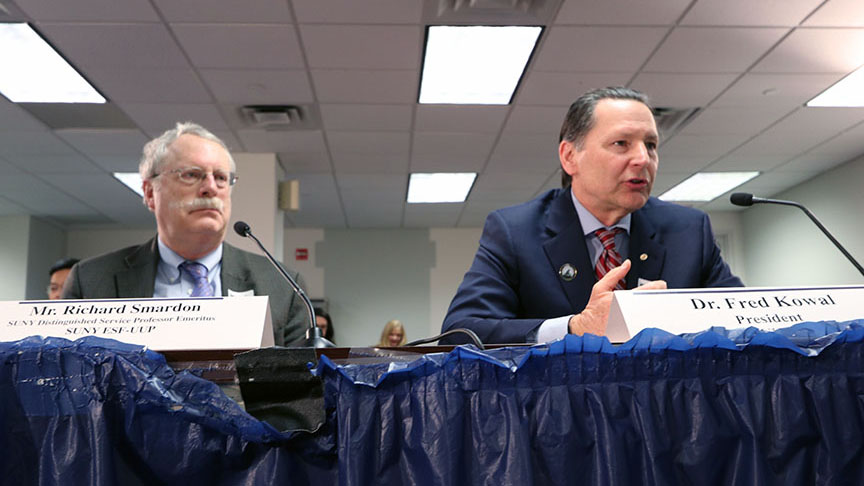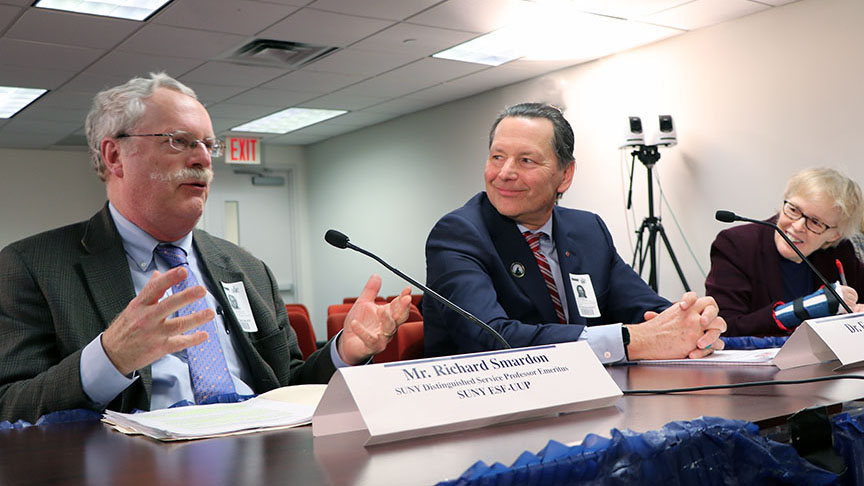December 16, 2019

There was Brooklyn and Buffalo, and New Paltz, Nassau and Syracuse.
Now, add the Big Apple to the list.
UUP President Fred Kowal, above, right, who has crisscrossed the state since October to advocate for SUNY at state hearings on funding SUNY and the future of higher education in New York, was in New York City Dec. 16 to testify on the possibility of creating a five-year capital plan for SUNY and CUNY.
Sen. Toby Stavisky, chair of the Senate’s Higher Education Committee, called the hearing, which was co-sponsored by committee member Sen. Robert Jackson.
“If those that have the power to make the changes and don’t do it, and the conditions keep getting worse, the message is loud and clear: we don’t care about you or your education,” said Jackson, D-Fort George.
Let SUNY lead
Kowal, who presented alongside Richard Smardon, above, left, a UUP member and a sustainability expert from SUNY’s College of Environmental Science & Forestry, urged the Legislature to let SUNY lead the way as the state begins its transition to green energy sources.
Kowal strongly supported a five-year capital plan for SUNY to ensure that new construction is built to meet the strict requirements of the state’s Climate Leadership and Community Protection Act. SUNY’s new and existing buildings should be built and retrofitted for net zero carbon emissions and standards.
“Preserving and protecting our environment is an issue that’s of major concern to UUP—and to me personally,” Kowal said. “Climate change is real, and we must take action to solve this problem now, before it’s too late. It can be done, it should be done, and SUNY is uniquely positioned to accomplish that task.”
SUNY owns over 2,900 buildings comprising 110 million square feet of space; more than 40 percent of the state’s buildings are owned by SUNY. Of those, 40 percent are over 50 years old.

Grow SUNY
Smardon, a SUNY Distinguished Service Professor Emeritus, pictured above with Kowal and Professional Staff Congress President Barbara Bowen, recommended that SUNY work to expand its green energy workforce training program; the University at Buffalo, SUNY Cortland and SUNY Oswego have graduate programs in place, while several other SUNY schools and community colleges offer bachelor’s degrees and continuing education programs.
Smardon said SUNY ESF is perfectly positioned to lead SUNY’s transition to green energy, echoing UUP’s newly proposed NY25 plan—which sets goals to keep SUNY accessible, promote SUNY’s public teaching hospitals, make SUNY a carbon neutral system, increase faculty diversity, and establish long-term financial resources.
He also suggested pairing SUNY schools with disadvantaged communities to help them develop and create renewable energy sources.
“We know it can be done,” he said.
Stavisky, D-Queens, and Jackson said they would work to push for a five-year plan for SUNY, which SUNY Senior Vice Chancellor Robert Haelen said is backed by SUNY. Haelen said SUNY has a five-year capital plan that would budget $5 billion for SUNY by 2025.
Jackson was more impressed by testimony from UUP and members of the Professional Staff Congress, the union that represents CUNY.
“I’m glad that our chairman held these hearings,” said Jackson. “This is like light being shined on problems that we’d not know about if these hearings never took place.”

